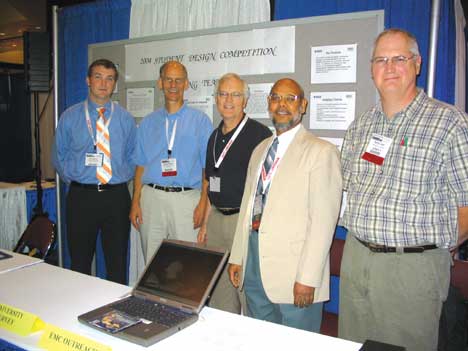 |
| Officers of the Education and Student
Activities Committee, including Bob Nelson, Vice-Chair (second
from left), Maqsood Mohd, Chair (second from right), and Randy
Jost, Secretary/Webmaster (far right), join one of the winners
of the Student Design Contest, Wes Williams from the University
of Tennesse at Knoxville (far left) and the EMC Newsletter’s
Technical Editor, Bob Olsen (center) at the IEEE EMC Symposium
in Santa Clara. |
If we are injured or inflicted with some type
of illness then we go to a physician and this professional brings
us back to the condition that we were in before the calamity.
If we run into a legal problem then we seek the services of a
lawyer and this professional ensures that we are in conformance
with the law and brings us back into the condition that we were
in before the incident. When we deal with an educator, however,
we enhance our understanding of a subject matter and this professional
makes us better than what we were before by improving our understanding,
knowledge, and reasoning power. Yet, there are societies that
do not “value” and “respect” an educator as
much as they deserve to be respected. In fact, the combination
of an educator and an education system could be used as a figure
of merit of a prosperous and bright future of any society. Educators
are builders of a newer generation that is more advanced than
them. We are very fortunate to have excellent educators in our
Society. Each year, these educators benefit us by making us improve
ourselves in the EMC subject matter. We are grateful to these
educators who put education and learning at the highest level
of importance in their lives. If we, as a Society, desire to lead
the current technology scene, we must promote education and learning
in our Society. We as a Society must strive to innovate the art
of EMC science through advanced learning and education. In my
decade of formal connection with the Society, I have never been
more excited and confident about our future than now. We have
some very talented young men and women in our midst who are on
a path to take the EMC science to greater heights and excellence.
I am pleased to report that the ESAC has been instrumental in
propelling the interest in EMC engineering and making this field
of science a worthwhile endeavor for our young men and women around
the world. Our decade old programs such as Fundamental Tutorials,
Experimental Demonstrations, The NARTE Exam preparation, and the
University Grant have continued to increase in their appeal and
participation by the membership. Even the “new kid on the
block” type programs such as the Best Student Paper Award,
and the Best Student Design Competition have been accepted and
have continued to increase in popularity at an exponentially increasing
rate. The success due to the amalgamation of all these ESAC programs
is palpable in the discussions and the knowledge base of the “customers”
who profit by attending the events organized and conducted by
the hardworking men and women of the ESAC. Every one of these
officers of the ESAC (listed below) deserves recognition for his/her
part in the success and for what their synergy brings to the overall
success of the ESAC. Next time you meet one of them, show your
appreciation for their dedication to promoting excellence in EMC
education and learning. We at the ESAC are not satisfied with
the success achieved thus far. We believe that there is always
room for improvement. If you have any ideas that you would like
to share with us to make ESAC better in accomplishing its charter,
then please contact any one of the officers listed below or me.
With your help and support, we will be on our way to becoming
the best committee in our Society and a model for other IEEE entities
to follow. The Boston, Massachusetts Symposium was a great success
for ESAC. With record attendance in every program and the new
threshold of excellence set in both the Best Student Paper Contest
and the Best Student Design Competition, we launched yet another
program called the “Partners in Education.” We have
had an encouraging response and we have a partnership with one
of the companies that specialize in EMC education software. We
still need help in this area. We need more partners to join us
in advancing the learning and education of EMC.
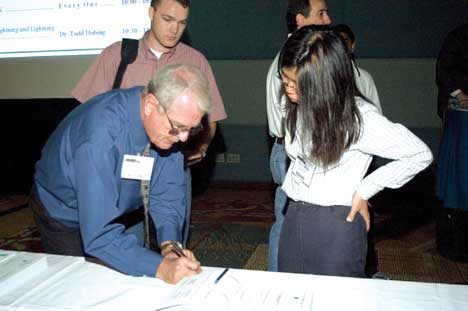 |
| Tom Van Doren explains the concept
of inductance to curious students after his tutorial presentation. |
Let me now provide you with the details of the ESAC activities
during the 2004 IEEE International Symposium on EMC in Santa Clara
for your reading pleasure and enjoyment.
Our big education events at the symposium included the Experiments
Demonstration and the Fundamentals Tutorial Workshop. Twelve years
ago, we started the Experiments Demonstration session, and eleven
years ago we started the Fundamentals Tutorial and NARTE Exam
Preparation workshops. A decade ago, on Mondays, the first day
of the Symposium, there was hardly any other workshop offered.
Over the years, the choice for the attendees has grown to almost
four workshops on Mondays. Thanks to our excellent speakers and
presenters, our Tutorial sessions have never lost their appeal
and utility. The real down to earth and fundamentals education
is really in demand. One of the reasons for this demand is that
the environment in which we live is becoming richer with man-made
electromagnetic energy and at the same time the susceptibility
threshold of electronic technology is decreasing. So, many are
in desperate need to know how to deal with EMI and EMC today.
The increasing participation of novices in this field at seminars
and symposia and even the desire of seasoned professionals to
brush-up and soak up every tidbit of EMC knowledge are noteworthy.
After all, knowledge is power! This makes our Committee’s
responsibility very important, and we don’t take that lightly.
We of ESAC, as in the past, will continue to strive to bring the
best in EMC Education. But, we are always open for new and beneficial
ideas.
Knowledge is power. And indeed education is the means to get the
knowledge. To seek knowledge is a birth right of every human being.
EMC professionals are included in this. It is never too late to
learn and seek education. Education is a verb. Our goal is to
become the premier education committee of the IEEE. This is your
Committee. We are here to help you and support your education
needs. We are striving to undertake unconventional and innovative
means to achieve our goals. Help us help you better. Let me update
you on activities of various subcommittees. We welcome your help
and support that you may be able to provide to any of our subcommittees.
Please feel free to contact any of these subcommittee Chairs.
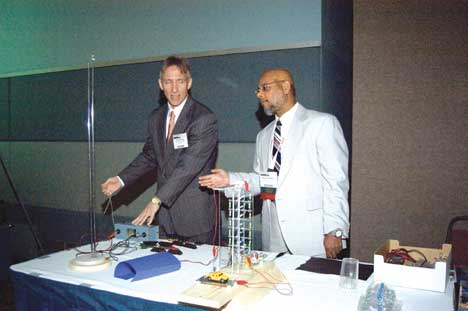 |
| Maqsood Mohd (right) supported Todd
Hubing in getting the lightning demonstration equipment ready
for the tutorial presentation. |
Santa Clara, California Symposium 2004
The Santa Clara, California Symposium is now behind us, and it
was the best yet for educating and enriching the EMC professionals.
The Santa Clara Symposium Committee deserves thanks and appreciation
for the job well done. At this symposium, the Education and Student
Activities Committee achieved great success in several areas.
In the following paragraphs, I have highlighted some of the events
that took place that you may find of interest.
Tutorials
It was another landmark year for the Fundamentals Tutorial. This
was the best year yet in its 11-year history. Although the tutorials
are primarily targeted for the entry-level engineers in the EMC
field, quite a few seasoned engineers also enjoy brushing-up on
concepts that they might not have used in a while. This year several
noted experts provided the tutorial material to help better understand
EMC concepts and to better design systems from an EMC point of
view. Highlights of the Tutorial include: introduction to EMC
effects, inductance effects, lightning effects and lightning protection,
use of dominant effect in diagnosis of EMC problems, bypass capacitors
effectiveness and techniques to improve PCB performance, and a
very informative panel discussion about challenges EMC professionals
face in their design work. If you did not attend the workshop,
we just wished that you were there.
Due to the overwhelming success of the 10th anniversary program
last year, we continued the two features that were added last
year. First, two topics and two speakers were planned to present
extended discussions on the subject of prime importance to an
EMC professional. Dr. Tom Van Doren presented a 90-minute tutorial
discussion on inductance effects and Dr. Clayton Paul presented
a 90-minute tutorial discussion on the concept of dominant effect
in the diagnosis of EMC problems. As expected, both IEEE Fellows
got rave reviews. Second, a panel discussion at the end of the
day was conducted. Even I was surprised how important and beneficial
the panel discussion was. The audience posed EMC questions to
one or more panelists and it was a real blast. The people were
glued to their seats even at 5:30 pm. We had to end the program
because of other planned activities. The other speakers included
Dr. Todd Hubing who enlightened the standing room only crowd about
lightning effects and how to protect from these effects. Dr. Howard
Johnson was also a stand out speaker on issues related to signal
integrity. We would like to thank all the speakers and the audience
for attending and making the panel discussion a great success.
It is our intent to continue with this feature in the second decade
of this very helpful and beneficial workshop.
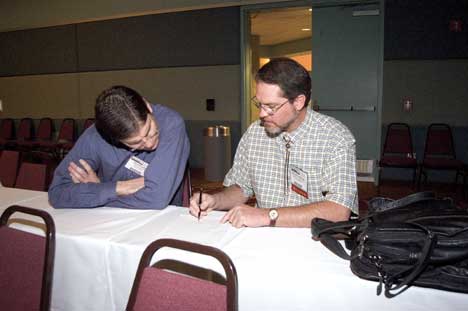 |
| Dr. Howard Johnson (right) explains
the combination of signal integrity and EMC effects to a curious
attendee after the presentation. |
If attendance is any measure of success and popularity, the Fundamentals
Tutorial was very successful. Throughout the day, on average there
was an impressive attendance of about 300 participants peaking
to 400. We had standing room only during the morning session and
more seats were added in the hall. We again noticed standing room
only in the afternoon session. Like previous years, this year
too the first-time attendees were about 40% to 50% of the total
attendance. Thanks to all the speakers and the attendees who made
the Fundamentals Tutorial a great success. The tutorial subcommittee
is busy planning for another exciting and informative session
during the Chicago Symposium. If you would like to propose a topic
or a speaker for the Chicago Symposium, email your comments and
ideas to maqsood@ieee.org.
Demonstrations
This is another popular and “educational” activity we
do as a committee. A variety of EMC concepts are demonstrated
experimentally and through modeling and simulation (M&S) during
the symposium to educate the symposium attendees. During the main
three days of the symposium, a total of 18 (8 experimental and
10 M&S) concepts were demonstrated that sometimes might be
classified as abstract or black magic. Many a happy soul was pleased
to learn these concepts during these demonstrations. Their doubts
changed into convincing beliefs.
Like the previous three years, the demonstrations were at the
best location in the symposium. The Santa Clara Symposium committee
worked closely with the ESAC to make this a success. The experiments
were solicited from a “Call for Experiments” and the
Symposium committee also arranged for the equipment for the presenters.
In the past, the ESAC used to do everything in this regard. This
has been a successful transition. We are almost in an autopilot
mode, and it has become a part of the main annual symposium committee
function. A minimal interaction will still be with the ESAC for
a foreseeable future, especially in an advisory role. The ESAC
representative who has helped champion this effort is Andy Drozd.
We want to recognize the invaluable service he has provided over
the years to the great success of this wonderful program. Our
thanks are due to the Santa Clara Symposium committee for a fine
job on arranging the Experimental Demonstrations. In fact, one
improvement made by the Santa Clara committee this year was to
have a comprehensive audio visual system at each of the demonstration
areas along with plenty of seats for the eager students to sit
down and soak up every tidbit of information presented by the
demonstrators. Our thanks are also due to very supportive vendors.
If you would like to demonstrate an experiment at the Chicago
symposium, please respond to the Call for Experiments. If you
would like to demonstrate an EMC modeling and simulation concept
at the next symposium in Chicago, please contact Maqsood at maqsood@ieee.org.
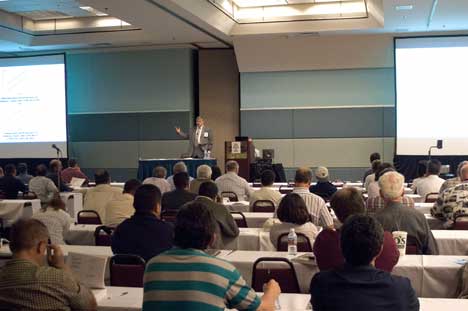 |
| Clayton Paul explains the concept
of dominant effect in diagnosing EMI issues to a crowded audience. |
NARTE Activities
As during the past 10 years, Dr. James Whalen conducted the workshop
for engineers and technicians who prepare to take the National
Association of Radio and Telecommunications Engineers (NARTE)
examination to certify as EMC engineers and technicians. Dr. James
Whalen is also a part of the overseeing committee of the EMCS
that reviews the question pool along with several folks from the
technical committees (TCs). At the NARTE examination on Friday,
several engineers and technicians sat for the exams. The word
from NARTE is that a number of the participants passed the exams.
Our congratulations to all the successful applicants, and welcome
to the ranks of certified NARTE professionals. Our thanks are
due to Dr. James Whalen for championing the cause of “preparing
for the NARTE exams.” Due to his selfless service to the
ESAC and by conducting this workshop during the last 11 years,
he has educated almost 500 engineers and technicians and his attendees
have a record of 70% passing in the first attempt to become NARTE
certified EMC engineers and technicians.
University Grant
John Howard heads the University Grant Committee. This year, however,
his committee has not been successful in finding a winner for
this grant. This year we had a reasonable response to the call
for proposals, but the committee could not reach a consensus on
the winner. The grant is provided to an institution that is on
the verge of offering an EMC course. The grant money is used as
seed money to start an EMC course as an established part of the
curriculum in the Electrical Engineering department. The grant
is open to all universities in the world. For more details, contact
John Howard at jhoward@emcguru.com.
University Survey
Professor Antonio Orlandi is the Chair of this subcommittee. The
mission of the university survey committee is to survey the universities
and collect data about the EMC course offering, student population,
modeling and simulation usage, etc. The data collected will help
EMCS and its members in various ways. Information will be useful
for prospective students, industry, employers, etc. If you have
not already done so, please complete an online survey by going
to the website https://dau.ing.univaq.it/art. If you know of a
school or a college that has not participated in the survey, please
encourage them to complete an online survey. For more information
on this activity please contact Professor Orlandi at orlandi@ing.univaq.it.
Student Design Competition
This has been one of the most exciting areas of growth during
last few years for our Committee. This effort epitomizes the proverbial
synergistic cooperative effort between industry and the Society.
Ahmad Fallah of Cisco Systems, Santa Clara, California, and Harold
Rudnick of Phoenix International of Fargo, North Dakota are the
Co-Chairs of this effort. This was our fifth year of conducting
this competition. In this competition, parts of a circuit (designed
by Fallah) in the form of a kit are sent to the professors at
the universities. The kit is yours for the asking. This year almost
34 kits were sent around the world. We received eight entries.
The entries were evaluated against a set of criteria provided
in the information packet sent with the kit. The evaluators are
EMC engineers from the industry and academia without any conflict
of interest.
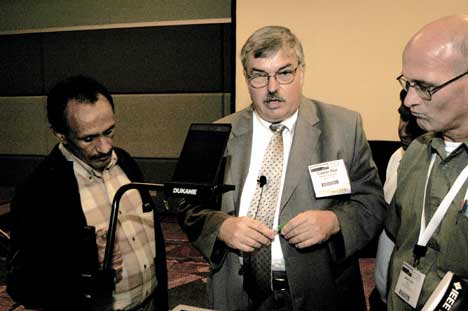 |
| Clayton Paul answered many individual
questions following his presentation in Santa Clara. |
The 2004 EMC Student Design Competitions was a major success!
In the 2004 competition, we had an excellent wining entry. The
winning entry team is from the University of Tennessee at Knoxville.
The team consists of three members: Wes Williams, Joshua Taylor,
and Brent Hatch. The team members presented an impressive poster
paper presentation in the demonstration area. The team qualified
to receive $900 in cash and one student from the winning team
received an expense-paid trip to attend the 2004 IEEE International
Symposium on EMC in Santa Clara, California. The most important
reward for the participants, however, was the experience of applying
their EMC design knowledge to a real-life problem and explaining
the EMI-reduction techniques to scores of professionals in the
symposium.
If you are a student and want to participate in the 2005 Student
Design Competition, then all you need to do is have your professor
contact us via email at ahmadfallah@ieee.org,
and request a design kit and a copy of the competition rules by
January 15, 2005. Follow the rules and submit a winning entry.
Get started early and remember, the early bird gets the worm.
The price is right: a free trip to the 2005 Chicago EMC symposium
and $900 US dollars! Not bad!
Experiments Manual On-line
Dr. Dick DuBroff has led this effort for last three years. He
has done extraordinary work to enhance the experiments manual.
He has developed a Volume II of the manual. We appreciate his
hard work and dedication to advance this effort. Thank you Dick
for your valuable effort in this area. The first Experiment Manual
was published by the Education and Student Activities Committee
and is on the web site at: https://www.ewh.ieee.org/soc/emcs/pdf/EMCman.pdf.
If you have an Adobe Acrobat Reader, you can download the entire
manual from this site. If you don’t have the Adobe Acrobat
Reader, it can easily be downloaded from the site: https://www.adobe.com.
If you would like to take a look at Volume II of the Experiment
Manual, then visit https://www.ewh.ieee.org/soc/emcs/edu/exper.htm.
Our new chair for this effort is Ed Wheeler of Rose-Hulman. Ed
can use some help from a volunteer who can support the follow-up
work of soliciting and arranging the new experiments. If you are
interested in broadening your career horizons, contact Ed or any
other officer of the Education and Student Activities Committee.
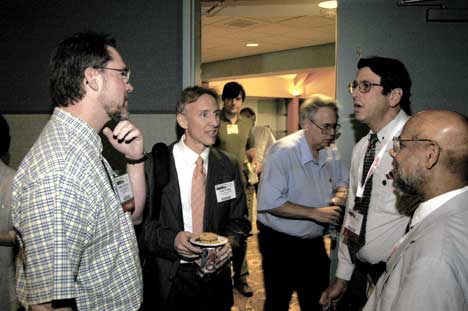 |
| Crosstalk between experts! Todd Hubing
is talking to Maqsood Mohd and Howard Johnson is talking to
Mark Montrose. |
Education Committee Web Site
Randy Jost of Utah State University is in charge of this subcommittee
as he has assumed the role of the Secretary of the ESAC officially
in August 2003. As the duties fall under secretary of the committee,
Randy Jost has done a superb job. Take a look at our web site
at https://www.ewh.ieee.org/
soc/emcs/edu/index.html. If you have any ideas to improve
our web site, please contact Randy or me.
Student Activities
Since this effort involved many activities and it was difficult
for one volunteer to accomplish everything, the efforts to undertake
the Student Design Competition and the Best Student Paper Contest
were separated from this activity. The scope of this committee
was adjusted so that it would be easier to accomplish the objectives
of this committee. Dr. Tom Jerse is the new Chair of this subcommittee.
The mission of this committee is to reach out and interact with
all students around. Primarily, he will focus on college campus
related activities (interfacing with IEEE student chapters, promoting
EMC in those chapters, and taking care of the President’s
Award, such as promotion, advertising, and seeking nominations
for it.) The first order of business is to introduce the student
chapters with EMC educational materials. If you have any ideas
or wish to volunteer, please contact Tom Jerse at jerset@citadel.edu.
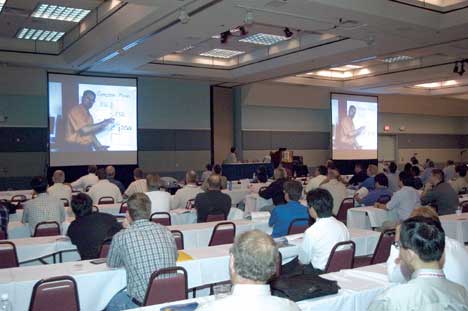 |
| Howard Johnson explains the details
of bypass capacitor effects to the crowded audience hall. |
Student Award Winners at the 2004 EMC Symposium
In addition to the Best Student Design Award, each year the Education
and Student Activities Committee also awards the Best Student
Paper Award at the annual Symposium event. The winning entry for
this year’s Best Student Paper Contest was “Graphical
Analysis of B-737 Airplane Pathloss Data for GPS and Evaluation
of Coupling Mitigation Techniques,” by Ms. Madiha Jafry of
the Department of Electrical and Computer Engineering, Old Dominion
University at Norfolk, Virginia. Her award included a cash award
of $900 and an expense paid trip to the Santa Clara Symposium.
Congratulations to Ms. Madiha Jafry for her excellent and innovative
paper about an interesting topic in the avionics industry. Regarding
the Best Student Design Competition, the winning entry for this
year was from the University of Tennessee at Knoxville. The team
members are Wes Williams, Josh Taylor, and Brent Hatch. The three
members of the team share a cash award of $900. The team members
got an expense paid trip to the Symposium in addition to the cash
award. This year only one team member was able to attend the symposium.
Congratulations to these students, their team members, their professors,
sponsors, and the universities.
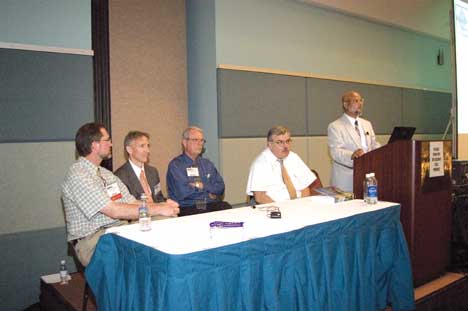 |
| Maqsood Mohd (far right) leads the
panel discussion at the end of the Fundamentals Tutorial workshop
and answered questions from the audience. |
Video/CD-ROM Based Educational Material
Production
The task of this committee is to produce educational material
in an appropriate and useful medium to the EMCS membership. Dick
Ford has been the Chair of this committee. This year Dick has
completed a milestone in the video productions arena. A CD-ROM
is produced that has three experiment demonstrations on it. The
experiments include the demonstration of “EMC Aspects of
Magnetic Field Coupling of Current Loops,” by Dr. Jasper
Goedbloed of Geldrop Netherlands. He is a professional of great
repute who worked for a number of years and retired from the Philips
Company in the Netherlands. He has authored an excellent book
on EMC and has been a featured presenter in the ESAC Fundamentals
Tutorial Workshop and the Experimental Demonstrations over the
years. The second demonstration included is titled “ESD and
EMI in Printed Wiring Boards,” by Doug Smith. Doug is well
known and respected throughout the EMC and ESD communities for
his high frequency measurements expertise. He worked for a number
of years and retired from AT&T Bell Labs. He has authored
an excellent book on EMC and has been a featured presenter in
the ESAC Fundamentals Tutorial Workshop and the Experimental Demonstrations
over the years. The third demonstration shows the “Effects
of Pulse Rise/Fall Time on Signal Spectra,” by Professor
Clayton Paul of Mercer University, in Macon, Georgia. Dr. Clayton
Paul has been an icon in the EMC Society for a number of years.
He is an IEEE Fellow, author of the first EMC book suitable for
an academic course, and he propelled the science of EMC engineering
from the “Black Magic” arena into scientifically computable
and understandable areas. He retired from the University of Kentucky
after teaching there for a number of years. He is a long-term
contributor to the ESAC Fundamentals Tutorial Workshop and Experimental
Demonstrations programs. He authored and edited the first EMC
Experiments Manual produced by the ESAC.
You don’t want to miss this CD if you are interested in learning
the concepts and actually conducting an experiment to duplicate
the concepts presented on it. This copyrighted material is available
to our membership through the ESAC. There is a plan to provide
these CDs to needy members. They will be provided to EMC Chapters,
professors, and other educators. To get a copy of this CD, contact
Bob Nelson or me. What we do in this committee has a far-reaching
impact in the 21st century. The educational material and the CD
that we produced will be valuable to EMC students and professionals
alike for a long time to come.
 |
| Maqsood Mohd, ESAC Chair, led the
annual meeting of the ESAC, and is supported by able Vice
Chair, Bob Nelson (right). |
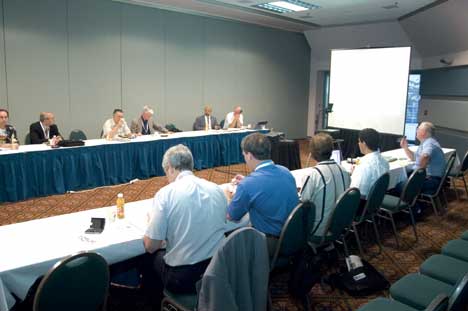 |
| The annual ESAC meeting in session.
All interested in education issues are invited to attend. |
EMC Outreach
The task of this committee is to produce educational material
in an appropriate and useful medium to the EMCS membership. The
outreach consists of three segments: the K-12 population, the
college student population, and the professional members who are
not fulltime students. We are beginning to devote our efforts
and resources to the K-12 population segment during the coming
months. If you have any ideas how to go about doing this job more
effectively, please contact me at maqsood@ieee.org.
Education and Student Activities Officers
Some changes have occurred during the Symposium. Contact any one
of the following to become a part of the ongoing innovation in
EMC engineering through education.
Experiments Manual II Ed Wheeler,
edward.wheeler@rose-hulman.edu
Student Activities Tom Jerse, jerset@citadel.edu
Student Design Contest Ahmad Fallah,
ahmadfallah@ieee.org
Harold Rudnick,
hrudnick@phoeintl.com
Secretary/Webmaster Randy Jost, rjost@ece.usu.edu
University Grant John Howard,
jhoward@emcguru.com
EMC Outreach Maqsood Mohd,
maqsood@ieee.org
Tutorials Maqsood Mohd
Vice Chair Bob Nelson,
robert.m.nelson@ndsu.nodak.edu
University Survey Antonio Orlandi,
orlandi@electtrica.ing.uniroma1.it
NARTE Jim Whalen,
jjw@eng.buffalo.edu
I would like to express my personal thanks and appreciation to
each of these officers who tirelessly work throughout the year
to bring the very best in EMC education materials, workshops,
demonstrations, tutorials, and student contests at every symposium
and to all the members of the EMC profession throughout the year.
When you email them, contact them, or see them during a symposium,
please express your appreciation for volunteering their valuable
time for the EMCS and the Education and Student Activities Committee.
EMC










